The first time I tasted Hawaiian beef stew, it felt like getting a taste of the islands. It’s a dish that brings together tropical flavors and comfort food. It’s not just any beef stew; it’s a trip through Hawaiian cuisine that makes simple ingredients special.
Hawaiian beef stew is more than a recipe. It shows the mix of cultures in Hawaii, where every ingredient has a story. The slow-cooked beef, mixed with tropical flavors, combines Portuguese, Asian, and Native Hawaiian cooking styles.
When you make this stew, you’re not just cooking. You’re bringing a piece of Pacific island heritage to your table. The long cooking time turns tough meat into tender, delicious bites. It shows the patience and care of traditional island cooking.
Table of Contents
The Cultural Heritage of Hawaiian Comfort Food
Hawaiian culinary traditions are a rich mix of cultures. They blend Japanese, Portuguese, Filipino, and indigenous flavors into unique dishes. This creates a vibrant island-inspired cuisine.
Food is at the heart of Hawaiian gatherings. It turns simple ingredients into powerful cultural expressions. The history of Hawaiian cuisine mirrors the islands’ diverse population.
Origins and Historical Significance
Hawaiian cuisine has deep roots. It was shaped by generations of immigrants. These workers from different backgrounds created a unique food culture that keeps evolving.
- Japanese immigrants introduced techniques like shave ice
- Chinese laborers brought dumpling and noodle traditions
- Portuguese settlers influenced baking and meat preparation
Evolution of Island Cuisine
Hawaii’s food scene has changed a lot. It now combines traditional cooking with new ideas. Dishes like loco moco and spam musubi show how Hawaiian food has adapted to new tastes and influences.
| Cultural Influence | Culinary Contribution |
|---|---|
| Japanese | Spam musubi, shave ice |
| Chinese | Manapua, noodle dishes |
| Portuguese | Malasadas, sausage techniques |
Family Traditions and Gatherings
In Hawaiian culture, meals are more than food. They celebrate community and connection. Each dish shares a story, linking generations through family recipes and cooking methods.
“Food brings us together, sharing memories and love with every bite.”
Essential Ingredients for Authentic Hawaiian Beef Stew
To make a great pineapple beef stew, you need the right ingredients. Start by picking top-notch proteins and fresh local produce. These choices will bring true island flavors to your dish.
The heart of a fantastic Hawaiian beef stew is the meat. You’ll want to use:
- 2 pounds of chuck roast, cut into 1½-inch cubes
- 2 pounds of smoked brisket for enhanced flavor
- 4 tablespoons of purpose flour for meat coating
- 2 teaspoons of sea salt
- 2 teaspoons of ground black pepper
Choosing the right vegetables is also key. They help create rich, complex tastes. Here are some essential vegetables:
- 1 medium yellow onion, finely chopped
- 2 large carrots, cut into ¾-inch pieces
- 6-8 celery stalks, chopped
- ½ cup of celery leaves
- 2-4 tablespoons of minced garlic
To make your stew even better, add some special Hawaiian touches:
- 2 tablespoons of shoyu (soy sauce)
- 2-4 tablespoons of fresh ginger
- 1 (6-ounce) can of tomato paste
- Optional: Fresh pineapple chunks for authentic island sweetness
By picking and mixing these ingredients, you’ll make a stew that feels like a trip to Hawaii.
Selecting and Preparing the Perfect Cut of Beef
Creating amazing beef recipes starts with picking the right meat. The key to a great Hawaiian beef stew is choosing top-quality beef. This beef becomes tender and full of flavor as it cooks.
Chuck roast is the top choice for Hawaiian beef stew. It has lots of marbling and a strong flavor. These qualities make it perfect for slow-cooking, where flavors really come out.
Choosing Premium Chuck Roast
When picking a chuck roast, look for these important qualities:
- Consistent, visible marbling throughout the meat
- Deep red color indicating freshness
- Minimum weight of 2 pounds for optimal stew preparation
- Preferably USDA Choice or Prime grade
Proper Trimming Techniques
Trimming your chuck roast needs careful work. Remove excessive external fat, but keep enough for moisture and flavor. Try to trim thick connective tissue while keeping some fat inside.
Marbling and Quality Indicators
Marbling is key in beef recipes. Look for fine, white fat streaks in the meat. These fat networks melt during slow cooking, making the stew tender and flavorful.
Pro tip: A well-marbled chuck roast can turn an ordinary stew into a memorable dish.
With the right selection and prep, your beef will shine in slow-cooked dishes. These dishes will truly capture the spirit of Hawaiian comfort food.
The Art of Hawaiian Seasoning Blends

Discover the secret to authentic tropical flavors with Hawaiian culinary traditions. These traditions turn an ordinary beef stew into a Pacific Island delicacy. The magic is in the carefully crafted seasoning blends that capture the essence of Hawaiian cuisine.
Hawaiian seasoning is a complex mix of flavors that shows the islands’ rich cultural heritage. Your beef stew will come alive with a unique mix of ingredients that dance on your palate:
- Sea salt harvested from Hawaiian volcanic regions
- Fresh ground black pepper
- Garlic powder
- Alaea red salt – a traditional Hawaiian ingredient
- Dried herbs like thyme and oregano
The key to mastering these tropical flavors is understanding the balance between savory, sweet, and umami elements. Traditional Hawaiian culinary traditions emphasize using local ingredients. These ingredients bring depth and complexity to every dish.
| Seasoning Component | Flavor Profile | Cultural Significance |
|---|---|---|
| Alaea Salt | Mineral-rich, slightly earthy | Sacred Hawaiian cultural ingredient |
| Garlic Powder | Pungent, aromatic | Introduced by immigrant cultures |
| Black Pepper | Sharp, warming | Global trade influence |
Your seasoning blend should be a personal expression of Hawaiian culinary artistry. Experiment with proportions and ingredients to create a signature flavor. This flavor should tell a story of island traditions and global influences.
Root Vegetables and Local Produce Selection
Island cuisine celebrates Hawaii’s rich agricultural heritage. It uses carefully selected vegetables to make a simple beef stew into a masterpiece. Local produce, like root vegetables, adds authentic flavor and nutrition to dishes.
Knowing the importance of local vegetables is key to making a true Hawaiian beef stew. The islands have a wide variety of nutritious ingredients. These ingredients make the dish more complex and culturally rich.
Traditional Hawaiian Root Crops
Hawaii’s volcanic soil grows unique root vegetables. These are essential to island cuisine. Key ingredients include:
- Taro (Kalo): A nutritional powerhouse packed with potassium, vitamin C, magnesium, and iron
- Purple sweet potatoes
- Breadfruit (‘Ulu)
- Yams
Seasonal Vegetable Combinations
Choosing seasonal vegetables boosts flavor and nutrition. Hawaiian culinary traditions focus on using fresh, local ingredients. These reflect the current harvest.
| Season | Recommended Vegetables |
|---|---|
| Spring | Tender green onions, young taro shoots |
| Summer | Zucchini, bell peppers, fresh herbs |
| Fall | Butternut squash, purple sweet potatoes |
| Winter | Root vegetables, hearty greens |
Proper Cutting Techniques
The way you cut vegetables affects the stew’s texture and flavor. Cutting vegetables into uniform, medium-sized pieces ensures even cooking. This creates a balanced blend of flavors in your Hawaiian beef stew.
- Cut root vegetables into 1-inch cubes
- Slice softer vegetables slightly larger to prevent disintegration
- Maintain consistent size for balanced cooking
Creating the Perfect Tomato-Based Gravy
Making the perfect tomato-based gravy is key to a great Hawaiian stew. It brings all the flavors together, making the stew rich and delicious.
Your gravy starts with the right ingredients:
- 2 tablespoons tomato paste
- 1 can (15 ounces) diced tomatoes
- 2 tablespoons soy sauce
- 2 tablespoons Worcestershire sauce
The trick to a great gravy is layering flavors. First, sauté diced onions and celery until they’re soft. This makes a flavorful base for your sauce.
| Ingredient | Quantity | Purpose |
|---|---|---|
| Tomato Paste | 2 tablespoons | Concentrated tomato flavor |
| Diced Tomatoes | 15 ounces | Texture and liquid base |
| Beef Broth | 2 cups | Depth of flavor |
Pro tip: For a smooth gravy, mix 2 tablespoons of cornstarch with water. This prevents lumps and makes the gravy silky.
Let your gravy simmer slowly. This lets the flavors blend well. You want it to be thick and shiny, coating the spoon. This will make your Hawaiian beef stew truly special.
Hawaiian Beef Stew: Slow Cooking Techniques
Mastering slow-cooked dishes takes patience and precision. Comforting stews like Hawaiian beef stew turn tough meat into tender, flavorful meals. Learning the details of slow cooking can improve your cooking skills and make meals as good as those in restaurants.
The secret of slow-cooked dishes is breaking down tough fibers. Your Hawaiian beef stew will get rich, deep flavors from controlled temperature and time.
Temperature Control Methods
Successful slow cooking needs consistent low heat. Professional chefs suggest these temperature tips:
- Start with medium-low heat (around 275°F)
- Keep the temperature steady throughout cooking
- Use a heavy-bottomed pot or slow cooker
- Avoid sudden temperature changes
Timing and Tenderness Tests
Checking meat tenderness is key. Cooking times change based on meat cut and desired texture. For Hawaiian beef stew, follow these tips:
- Chuck roast usually cooks for 2-3 hours
- Slow cooker method: 6-8 hours on low setting
- Check tenderness by gently pulling meat with a fork
- Meat should easily separate when fully cooked
Flavor Development Stages
Stews get complex through layered cooking stages. Each hour of slow cooking deepens flavors, blending spices, meat, and vegetables.
Patience transforms simple ingredients into an extraordinary meal.
Your Hawaiian beef stew will be at its best after 2-3 hours of slow cooking. The result is a tender, rich, and satisfying meal that captures the essence of traditional Hawaiian cuisine.
Traditional Serving Suggestions and Accompaniments

When you make Hawaiian beef stew, picking the right sides can make it unforgettable. White rice is a classic choice, great for soaking up the stew’s rich gravy.
Here are some traditional sides that go well with your beef stew:
- Steamed white rice (loved by 70% of stew fans)
- Cornbread muffins (enjoyed by nearly 60% of cooks)
- Fresh garden salad with crisp veggies
- Homemade garlic bread (favored by 75% of stew makers)
Adding light vegetable sides is key to a balanced meal. About 50% of stew recipes don’t have enough veggies. Adding fresh produce boosts both taste and nutrition.
| Side Dish | Preparation Time | Nutritional Benefit |
|---|---|---|
| Roasted Broccolini | 15 minutes | High in vitamins |
| Garden Tomato Salad | 10 minutes | Light and refreshing |
| Asparagus with Rosemary | 20 minutes | Rich in nutrients |
Try to make a meal that shows off Hawaiian cooking traditions. Experiment with different sides to find your favorite!
Storage and Preservation Methods
When you make comforting stews like Hawaiian beef stew, storing them right is key. Cool your stew quickly at room temperature after cooking. Always put leftovers in the fridge within two hours to keep them safe and tasty.
Use airtight, shallow containers to keep your stews fresh. Refrigerated Hawaiian beef stew stays good for 3-4 days if sealed well. Freezing is also great for longer storage. Divide the stew into portions, leaving space for it to expand when it freezes.
To thaw frozen stew, let it sit in the fridge overnight. Reheat it slowly on the stovetop or in the microwave, stirring often. Adding a bit of broth or water helps keep the stew moist and flavorful.
Good storage keeps your meals fresh for longer. It lets you enjoy comforting stews whenever you want. With these easy tips, you’ll always have a tasty meal ready to go.
FAQ
What makes Hawaiian beef stew different from traditional mainland beef stews?
Hawaiian beef stew stands out with its tropical flavors. It often includes pineapple, local veggies, and a special seasoning. This mix of sweet and savory flavors shows Hawaii’s diverse cooking traditions.
What is the best cut of beef to use for Hawaiian beef stew?
Chuck roast is the top choice for Hawaiian beef stew. Its marbling and tough fibers make the meat tender and flavorful after slow cooking.
How long should I cook Hawaiian beef stew?
For tender meat and rich flavors, slow cook it for 2-3 hours. This low temperature ensures the meat is tender and the flavors blend well.
Can I make Hawaiian beef stew in advance?
Yes, it’s even better when made ahead. Refrigerate it for 3-4 days or freeze for up to 3 months. The flavors get better over time, making it a great make-ahead meal.
What are the traditional side dishes served with Hawaiian beef stew?
White rice is the classic side. You can also serve it with macaroni salad, steamed veggies, or Hawaiian sides like poi or lomi-lomi salmon for a full island meal.
Is pineapple a traditional ingredient in Hawaiian beef stew?
Pineapple is a popular but optional ingredient. It adds a sweet and tangy flavor that complements the savory beef and enhances the stew’s tropical taste.
What makes the seasoning in Hawaiian beef stew unique?
The seasonings blend Hawaiian, Portuguese, and Asian flavors. Ingredients like soy sauce, ginger, garlic, and local herbs create a rich, umami flavor unique to island cuisine.
Can I make Hawaiian beef stew in a slow cooker?
Yes, a slow cooker is great for Hawaiian beef stew. It cooks the meat tender and develops flavors fully. Cook on low for 6-8 hours or high for 3-4 hours.
Source Links
- 92 Comfort Food Recipes You Won’t Believe Are Diabetic-Friendly – https://www.tasteofhome.com/collection/diabetic-friendly-comfort-foods/?srsltid=AfmBOoriE9gytz8wONdqgH_3LQybldWi2K0KGkxGay9x4bZZwxy0f5ch
- Hawaiian-Style Lemongrass Adobo Grilled Chicken With Pineapple – https://www.foodgal.com/2024/07/hawaiian-style-lemongrass-adobo-grilled-chicken-with-pineapple/
- 15 cities with the most tantalizing food scenes – https://www.lonelyplanet.com/articles/best-food-cities
- 10 Classic Hawaiian Foods to Try That Aren’t Poke – https://matadornetwork.com/read/classic-hawaiian-foods/
- Loco Moco Is The Beloved, Savory Hawaiian Dish You Should Know – Tasting Table – https://www.tastingtable.com/1379643/loco-moco-savory-hawaiian-dish/
- Sheldon’s Hawaiian Beef Stew / Beef / Recipes | Cooking with Aloha, Texas Style – https://www.cooking-with-aloha-texas-style.com/recipes/beef/sheldon-s-hawaiian-beef-stew
- Instant Pot Hawaiian Beef Stew – https://www.corriecooks.com/instant-pot-hawaiian-beef-stew/
- Hawaiian beef stew recipe: 7 easy steps for a hearty meal – https://www.tryfreshrecipes.com/hawaiian-beef-stew-recipe/
- Hawaiian Beef Stew Recipe with Tender Beef and Rich Gravy – https://www.thekitchnrecipes.com/hawaiian-beef-stew-recipe/
- Hawaiian Beef Stew Recipe – https://www.miraclerestaurantgroup.com/beef/hawaiian-beef-stew-recipe/
- Beef Stew Recipe: {7 Secrets for the Richest, Most Flavorful Comfort Food! } – https://allfood.recipes/crock-pot-recipes/beef-stew-recipe/
- Rushin Beef Stew Recipe By Shannon K. I’i • Cooking Hawaiian Style – https://cookinghawaiianstyle.com/shannon-k-li-rushin-beef-stew/
- Ulu Stew by Chef Noa Alo of Hailis • Cooking Hawaiian Style – https://cookinghawaiianstyle.com/chef-noa-alo-ulu-stew/
- Dive Into Hawaiian Cuisine: Food From Around the World – https://www.revealedtravelguides.com/blog/dive-into-hawaiian-cuisine-food-from-around-the-world/
- Hawaii schools push local and scratch – https://www.foodservicedirector.com/k-12-schools/hawaii-schools-push-local-and-scratch
- Easy Hawaiian Beef Stew – Little Sunny Kitchen – https://littlesunnykitchen.com/hawaiian-beef-stew/
- Guinness Beef Stew – https://www.munchkintime.com/guinness-beef-stew/
- The Best Ever Beef Stew Recipe (video) – https://tatyanaseverydayfood.com/beef-stew/
- Hawaiian Beef Stew – https://imhungryforthat.com/hawaiian-beef-stew/
- Hawaiian Beef Stew – https://sugarlesscrystals.com/hawaiian-beef-stew/
- 17 Sides To Serve With Beef Stew – https://www.southernliving.com/sides-to-serve-with-beef-stew-8578845?srsltid=AfmBOoo3wh-8ro1X6-8Dwo0k8ZQdUvp0p8-D1Aw1ODjrbz3KeANmBz4d
- What to Serve with Beef Bourguignon (13 Savory Side Dishes) – https://insanelygoodrecipes.com/what-to-serve-with-beef-bourguignon/
- 57 Sides for Soup You’ve Got to Try This Winter – https://www.tasteofhome.com/collection/sides-for-soup/?srsltid=AfmBOoomYw2ajPKupYIh4aRzLYvtuV4u52HmETPu9PhyhPKcKFlzbcg7
- Unlocking the Secrets of Bouillon Cubes: The Ultimate Guide to Flavorful Broths and Soups – https://loyal-machine.com/blog/bouillon-stock-cubes/
- Preserve Your Own SALSA! – https://www.attainable-sustainable.net/preserving-tomatoes-as-salsa/









